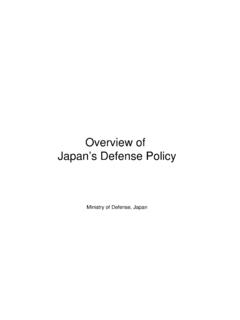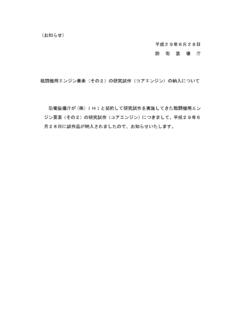Transcription of DOJ 2017 EN web - mod.go.jp
1 Reference 1 Number of Nuclear Warheads Arsenals by Country and Their Major Means of DeliveryUnited StatesRussiaUnited KingdomFranceChinaMissilesICBM(Intercont inental Ballistic Missiles)450 Minuteman III: 450324SS-18: 54SS-19: 30SS-25: 90SS-27: 78RS-24: 72 52DF-5 (CSS-4): 20DF-31 (CSS-10): 32 IRBMMRBM 160DF-4 (CSS-3): 10DF-21 (CSS-5): 134DF-26 16 SLBM(Submarine Launched Ballistic Missiles)336 Trident D-5: 336192SS-N-18: 48SS-N-23: 96SS-N-32: 4848 Trident D-5: 4864M-45: 16M-51: 4848JL-2 (CSS-NX-14): 48 Submarines equipped with nuclear ballistic missiles1413444 Aircraft78B-2: 20B-52: 5876Tu-95 (Bear): 60Tu-160 (Blackjack): 16 63 Mirage2000N: 23 Rafale: 4060H-6K: 60 Number of warheadsApprox.
2 4,500 Approx. 4,490 (including Approx. 2,000 tactical nuclear warheads)215300 Approx. 260 Notes:1. Data is based on The Military Balance 2017 , the SIPRI Yearbook 2016, In January 2017 , the United States released the following figures based on the new Strategic Arms Reduction Treaty between the United States and Russia as of September 1, 2016 the number of deployed strategic nuclear warheads for the United States was 1,367 and the delivery vehicles involved 681 missiles/aircraft; the number of deployed strategic nuclear warheads for Russia was 1,796 and the delivery vehicles involved 508 missiles/aircraft. However, according to the SIPRI database, as of January 2016, the number of deployed nuclear warheads was approx. 1,930 (including 180 tactical nuclear warheads).
3 3. In November 2015, the s Strategic Defence and Security Review (SDSR) stipulated that the number of deployed nuclear warheads is to be no more than 120, while the number of nuclear warheads possessed is to be no more than According to the SIPRI database, India possesses 100-120 nuclear warheads, Pakistan 110-130, Israel a maximum of 80, and North Korea 2 Outline of Military Power of Major Countries and Regions (Approximate Numbers)Ground ForcesNaval ForcesAir ForcesCountry orRegionGround Forces (10,000 persons)Country orRegionTonnage(10,000tons)Number of VesselsCountry orRegionNumber of Combat AircraftIndia120 United States3, ,054 China2,722 North ,325 Pakistan56 United of of Korea618 United of :1. Data on ground forces and air forces is taken from The Military Balance 2017 and other sources, and data on naval forces is taken from Jane s Fighting Ships 2016 2017 and other Figures for Japan show the actual strength of its Self-Defense Forces as of the end of FY2016, and combat aircraft (Air Forces) include ASDF combat aircraft (excluding transports) and MSDF combat aircraft (only those with fixed wings).
4 3. Arrangement is in order of the scale of armed 3 Outline of Regular and Reserve Forces of Major Countries and Regions (Approximate Numbers)Country or RegionMilitary Service SystemRegular (10,000 persons)Reserves(10,000 persons)United StatesVolunteer13884 RussiaConscription / Volunteer83200 United KingdomVolunteer158 FranceVolunteer203 GermanyVolunteer183 ItalyVolunteer172 IndiaVolunteer140116 ChinaConscription21851 North KoreaConscription11960 Republic of ( ) :1. Data from The Military Balance 2017 and other Figures for Japan show the actual strength of its Ground, Maritime, and Air Self-Defense Forces as of the end of FY2016. The figure in parentheses shows the number of SDF Ready Reserve Personnel and is not included in the total Russia uses a personnel augmentation system which adds a contract employment system (a type of volunteer system)
5 To the preexisting conscription In Germany, as a result of the enactment of the Military Law Amendment Act in April 2011, the conscription system was suspended effective July 1, 2011, and the volunteer system was newly introduced as a replacement of the China has announced that the PLA would be reduced by 300,000 troops by the end of of JapanReferenceReference 4 Transition of Military Power in the Area Surrounding JapanFar East RussiaChinaJapanNorth KoreaFar East RussiaChinaJapanNorth KoreaFar East RussiaChinaJapanNorth Korea050100150200250(10,000 persons)(10,000 tons)(Number of Combat Aircraft)1997200720171997200720171997200 7201705010015020025002,0 004,0 006,0 008,0 00 Ground ForcesMaritime ForcesAir ForcesReference 5 National Security Strategy (Outline)(Approved by the National Security Council and the Cabinet on December 17, 2013)I.
6 Purpose As Japan s security environment becomes ever more severe, Japan needs to identify its national interests from a long-term perspective, determine the course it should pursue in the international community, and adopt a whole-government approach for national security policies and measures in order to continue developing a prosperous and peaceful society. In a world where globalization continues, Japan should play an even more proactive role as a major global player in the international community. The Strategy, as fundamental policies pertaining to national security, presents guidelines for policies in areas related to national security. With the National Security Council (NSC) serving as the control tower, as well as with strong political leadership, the Government of Japan will implement national security policies in a more strategic and structured manner through a whole-government approach.
7 When implementing policies in other areas, the Government of Japan will give due consideration to national security so that Japan can utilize its strengths, such as its diplomatic ability and defense capability, in a smooth and fully-functional way as a whole, based on the Strategy. The Strategy will guide Japan s national security policy over the next decade. Through the implementation of concrete policies, the NSC will regularly carry out systematic evaluation and upgrade the Strategy in a timely and appropriate Fundamental Principle of National Security1. Principles Japan Upholds Japan is a country with rich culture and tradition, and upholds universal values, such as freedom, democracy, respect for fundamental human rights and the rule of law.
8 Japan has a wealth of highly educated human capital and high cultural standards, and is an economic power with strong economic capacity and high technological capabilities. Japan has achieved its development benefiting from an open international economic system. In addition, Japan as a maritime state has pursued Open and Stable Seas. Japan has consistently followed the path of a peace-loving nation since the end of World War II, and has adhered to a basic policy of maintaining an exclusively national defense-oriented policy, not becoming a military power that poses a threat to other countries, and observing the Three Non-Nuclear Principles. Japan has maintained its security, and contributed to peace and stability in the Asia-Pacific region, by enhancing its alliance with the United States ( ), as well as by deepening cooperative relationships with other countries.
9 Japan has also contributed to the realization of stability and prosperity in the international community through initiatives for supporting the economic growth of developing countries and for addressing global issues based on the principle of human security, as well as through trade and investment relations with other countries. Complying with the United Nations ( ) Charter, Japan has been cooperating with the and other international organizations, and has actively contributed to their activities. Japan has also continuously participated in international peace cooperation activities. In addition, as the only country to have ever suffered atomic bombings in war, Japan has consistently engaged in disarmament and non-proliferation efforts, playing a leading role in international initiatives to realize a world free of nuclear weapons.
10 Japan will continue to adhere to the course that it has taken to date as a peace-loving nation, and as a major player in world politics and economy, contribute even more proactively in securing peace, stability, and prosperity of the international community, while achieving its own security as well as peace and stability in the Asia-Pacific region, as a Proactive Contributor to Peace based on the principle of international cooperation. This is the fundamental principle of national security that Japan should stand to Japan s National Interests and National Security ObjectivesNational Interests To maintain its sovereignty and independence; to defend its territorial integrity; to ensure the safety of life, person, and properties of its nationals, and to ensure its survival while maintaining its own peace and security and preserving its rich culture and tradition.
















